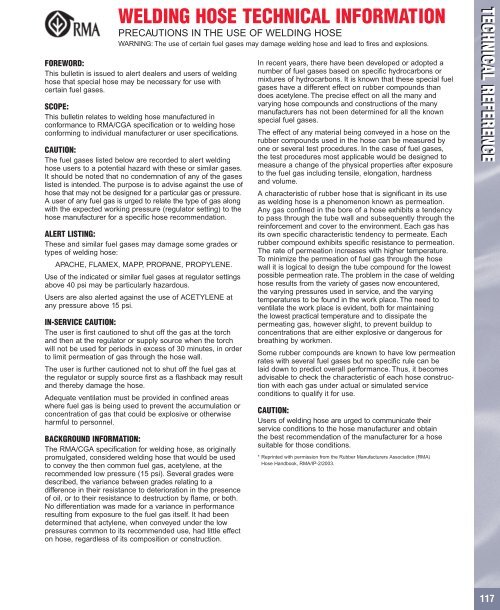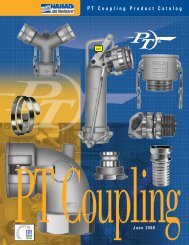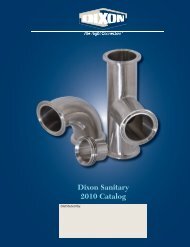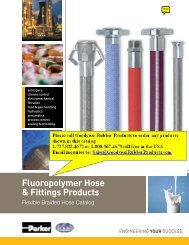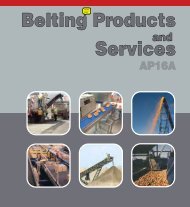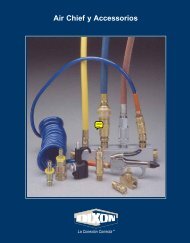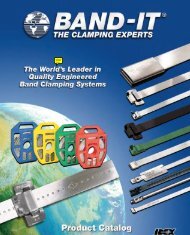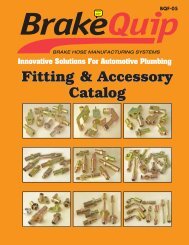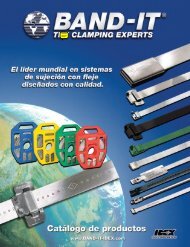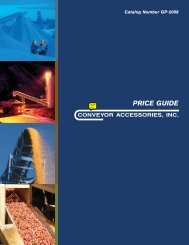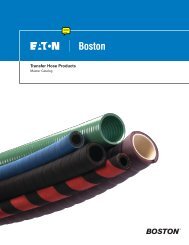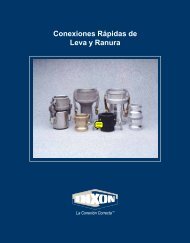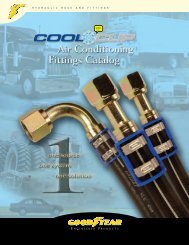HOSE PRODUCTS
Thermoid Industrial Hose Division - Goodyear
Thermoid Industrial Hose Division - Goodyear
- No tags were found...
You also want an ePaper? Increase the reach of your titles
YUMPU automatically turns print PDFs into web optimized ePapers that Google loves.
WELDING <strong>HOSE</strong> TECHNICAL INFORMATION<br />
PRECAUTIONS IN THE USE OF WELDING <strong>HOSE</strong><br />
WARNING: The use of certain fuel gases may damage welding hose and lead to fires and explosions.<br />
FOREWORD:<br />
This bulletin is issued to alert dealers and users of welding<br />
hose that special hose may be necessary for use with<br />
certain fuel gases.<br />
SCOPE:<br />
This bulletin relates to welding hose manufactured in<br />
conformance to RMA/CGA specification or to welding hose<br />
conforming to individual manufacturer or user specifications.<br />
CAUTION:<br />
The fuel gases listed below are recorded to alert welding<br />
hose users to a potential hazard with these or similar gases.<br />
It should be noted that no condemnation of any of the gases<br />
listed is intended. The purpose is to advise against the use of<br />
hose that may not be designed for a particular gas or pressure.<br />
A user of any fuel gas is urged to relate the type of gas along<br />
with the expected working pressure (regulator setting) to the<br />
hose manufacturer for a specific hose recommendation.<br />
ALERT LISTING:<br />
These and similar fuel gases may damage some grades or<br />
types of welding hose:<br />
APACHE, FLAMEX, MAPP, PROPANE, PROPYLENE.<br />
Use of the indicated or similar fuel gases at regulator settings<br />
above 40 psi may be particularly hazardous.<br />
Users are also alerted against the use of ACETYLENE at<br />
any pressure above 15 psi.<br />
IN-SERVICE CAUTION:<br />
The user is first cautioned to shut off the gas at the torch<br />
and then at the regulator or supply source when the torch<br />
will not be used for periods in excess of 30 minutes, in order<br />
to limit permeation of gas through the hose wall.<br />
The user is further cautioned not to shut off the fuel gas at<br />
the regulator or supply source first as a flashback may result<br />
and thereby damage the hose.<br />
Adequate ventilation must be provided in confined areas<br />
where fuel gas is being used to prevent the accumulation or<br />
concentration of gas that could be explosive or otherwise<br />
harmful to personnel.<br />
BACKGROUND INFORMATION:<br />
The RMA/CGA specification for welding hose, as originally<br />
promulgated, considered welding hose that would be used<br />
to convey the then common fuel gas, acetylene, at the<br />
recommended low pressure (15 psi). Several grades were<br />
described, the variance between grades relating to a<br />
difference in their resistance to deterioration in the presence<br />
of oil, or to their resistance to destruction by flame, or both.<br />
No differentiation was made for a variance in performance<br />
resulting from exposure to the fuel gas itself. It had been<br />
determined that actylene, when conveyed under the low<br />
pressures common to its recommended use, had little effect<br />
on hose, regardless of its composition or construction.<br />
In recent years, there have been developed or adopted a<br />
number of fuel gases based on specific hydrocarbons or<br />
mixtures of hydrocarbons. It is known that these special fuel<br />
gases have a different effect on rubber compounds than<br />
does acetylene. The precise effect on all the many and<br />
varying hose compounds and constructions of the many<br />
manufacturers has not been determined for all the known<br />
special fuel gases.<br />
The effect of any material being conveyed in a hose on the<br />
rubber compounds used in the hose can be measured by<br />
one or several test procedures. In the case of fuel gases,<br />
the test procedures most applicable would be designed to<br />
measure a change of the physical properties after exposure<br />
to the fuel gas including tensile, elongation, hardness<br />
and volume.<br />
A characteristic of rubber hose that is significant in its use<br />
as welding hose is a phenomenon known as permeation.<br />
Any gas confined in the bore of a hose exhibits a tendency<br />
to pass through the tube wall and subsequently through the<br />
reinforcement and cover to the environment. Each gas has<br />
its own specific characteristic tendency to permeate. Each<br />
rubber compound exhibits specific resistance to permeation.<br />
The rate of permeation increases with higher temperature.<br />
To minimize the permeation of fuel gas through the hose<br />
wall it is logical to design the tube compound for the lowest<br />
possible permeation rate. The problem in the case of welding<br />
hose results from the variety of gases now encountered,<br />
the varying pressures used in service, and the varying<br />
temperatures to be found in the work place. The need to<br />
ventilate the work place is evident, both for maintaining<br />
the lowest practical temperature and to dissipate the<br />
permeating gas, however slight, to prevent buildup to<br />
concentrations that are either explosive or dangerous for<br />
breathing by workmen.<br />
Some rubber compounds are known to have low permeation<br />
rates with several fuel gases but no specific rule can be<br />
laid down to predict overall performance. Thus, it becomes<br />
advisable to check the characteristic of each hose construction<br />
with each gas under actual or simulated service<br />
conditions to qualify it for use.<br />
CAUTION:<br />
Users of welding hose are urged to communicate their<br />
service conditions to the hose manufacturer and obtain<br />
the best recommendation of the manufacturer for a hose<br />
suitable for those conditions.<br />
* Reprinted with permission from the Rubber Manufacturers Association (RMA)<br />
Hose Handbook, RMA/IP-2/2003.<br />
TECHNICAL REFERENCE<br />
117


